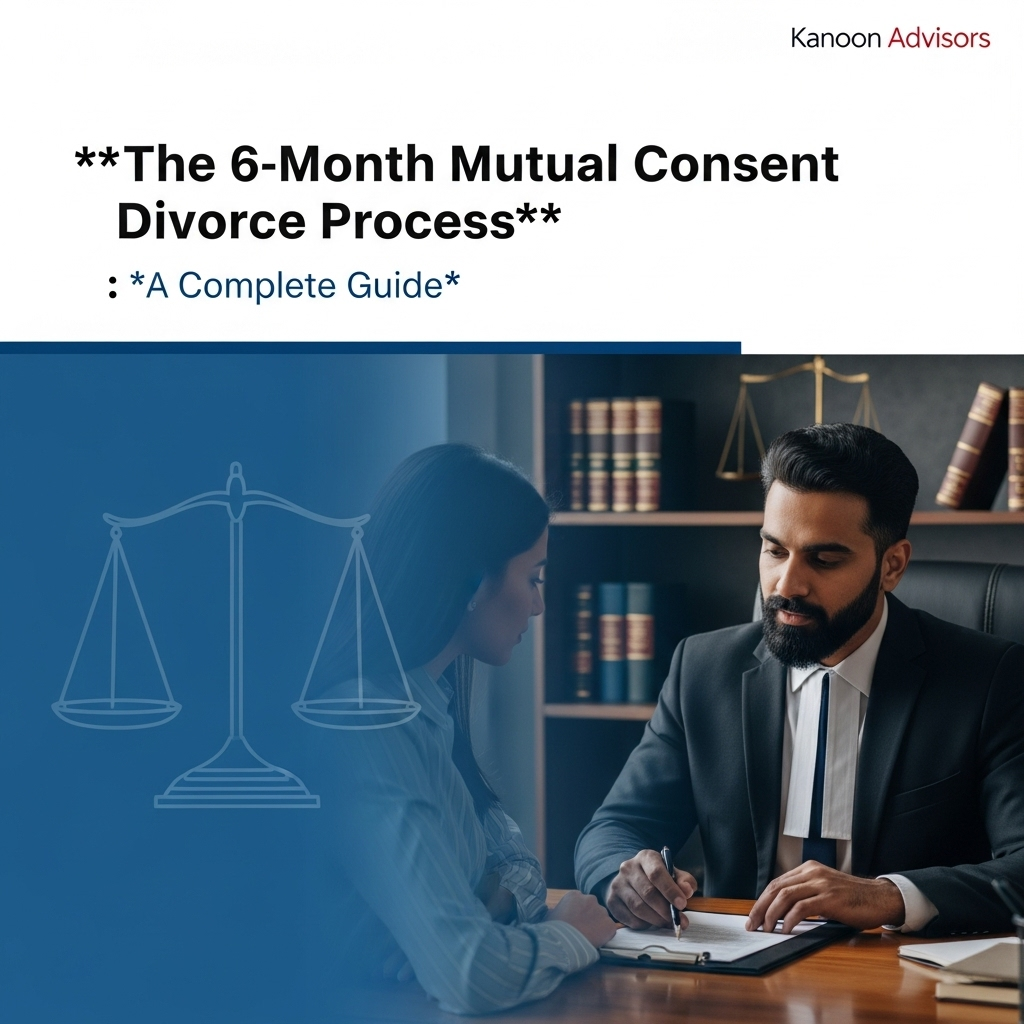
The 6-Month Mutual Consent Divorce Process: A Complete Guide
Quick Answer
Mutual consent divorce is the quickest legal route for couples to part ways amicably under Indian law. According to legal data, these cases have a high success rate, with court statistics showing over 90% are granted when filed correctly. To start the process, you must: 1. Ensure both parties agree on all terms, 2. Prepare a joint petition with a lawyer, and 3. File the petition in the appropriate family court.
Table of Contents
- Introduction to Mutual Consent Divorce
- Understanding Mutual Consent Divorce in India
- The 6-Step Legal Procedure for Mutual Consent Divorce
- Key Legal Considerations and Documentation
- Why Choose Kanoon Advisors for Your Case
- Related Legal Services
- Frequently Asked Questions
- Conclusion: Navigating Your Divorce with Confidence
Introduction to Mutual Consent Divorce
Embarking on the path of separation is undoubtedly one of life’s most challenging journeys. However, Indian law provides a dignified and efficient route for couples who have mutually decided to part ways: the mutual consent divorce. Unlike contentious legal battles that can drag on for years, causing immense emotional and financial strain, a mutual consent divorce streamlines the process, allowing both parties to move forward with their lives respectfully and expediently. This process is founded on the principle of mutual agreement, making it the most amicable and time-effective method of legal separation available today.
At The Kanoon Advisors, our 40+ years of collective experience in family law across Delhi NCR has shown us that a clear understanding of the procedure is the first step toward a peaceful resolution. This comprehensive guide is designed to demystify the 6-month legal timeline, outlining each step, the necessary documentation, and the critical legal considerations involved. Whether you are in Delhi, Gurgaon, Faridabad, or Noida, this article will serve as your definitive roadmap to navigating the mutual consent divorce procedure with clarity and confidence.
Understanding Mutual Consent Divorce in India
Before delving into the procedural steps, it’s crucial to grasp the legal foundation of mutual consent divorce. This understanding ensures that both partners are on the same page regarding their eligibility and the stark advantages this path offers over a contested divorce.
What is Mutual Consent Divorce?
Mutual consent divorce is a legal process where both spouses mutually agree to dissolve their marriage. The primary legal provision governing this for Hindus, Buddhists, Sikhs, and Jains is Section 13B of the Hindu Marriage Act, 1955. Similar provisions exist under other personal laws, such as Section 28 of the Special Marriage Act, 1954, and Section 10A of the Indian Divorce Act, 1869 (for Christians). The cornerstone of this process is the irretrievable breakdown of the marriage, acknowledged by both parties without leveling allegations against each other. According to court statistics, this non-adversarial approach results in a significantly higher rate of successful resolutions compared to contested matters.
Who is Eligible for a Mutual Consent Divorce?
To file for a mutual consent divorce under Section 13B, couples must meet specific legal prerequisites mandated by the courts. These are non-negotiable and form the basis of the petition.
- Minimum Separation Period: The spouses must have been living separately for a period of at least one year immediately preceding the presentation of the divorce petition. “Living separately” does not necessarily mean living in different locations; it can also mean living under the same roof but not as husband and wife.
- Inability to Live Together: Both parties must have mutually concluded that they can no longer live together and that the marriage has broken down irretrievably.
- Mutual Agreement on Terms: Crucially, both spouses must have agreed upon the terms of the divorce. This includes the settlement of all related issues like alimony (maintenance), division of assets/property, and, if applicable, child custody and support.
Mutual Consent vs. Contested Divorce: A Comparison
Choosing the path of mutual consent offers profound benefits in terms of time, cost, and emotional well-being. The differences are stark, as highlighted in the table below, which our legal team at Kanoon Advisors frequently uses to counsel clients in Delhi NCR.
| Feature | Mutual Consent Divorce | Contested Divorce |
|---|---|---|
| Timeframe | Typically 6 to 18 months | Can take 3 to 7 years, or even longer |
| Cost | Significantly lower due to fewer hearings | High legal fees due to prolonged litigation |
| Emotional Stress | Minimal, as it’s a collaborative process | Extremely high for the couple and children |
| Privacy | More private as no allegations are made | Becomes a public record with detailed allegations |
| Outcome Control | Couples decide the terms themselves | A judge decides the outcome, which may not satisfy either party |
The 6-Step Legal Procedure for Mutual Consent Divorce
The mutual consent divorce procedure is structured and systematic. It involves two court appearances, known as the First Motion and the Second Motion, separated by a mandatory “cooling-off” period. Here is a detailed breakdown of the entire process from start to finish.
Step 1: Reaching a Mutual Agreement & Drafting the Petition
This is the foundational step. Before approaching the court, both spouses must have a comprehensive discussion and reach a consensus on all pertinent issues. This agreement, often formalized in a Memorandum of Understanding (MoU), should cover alimony/maintenance (full and final settlement), child custody, visitation rights, and the division of all marital assets and liabilities. Once the terms are finalized, a joint divorce petition is drafted by a lawyer. This petition clearly states the reasons for the inability to continue the marriage and includes the terms of the settlement.
Step 2: Filing the First Motion Petition
The joint petition, along with the required documents and affidavits, is filed in the appropriate Family Court. The jurisdiction is determined by where the marriage was solemnized, where the couple last resided together, or where the wife is currently residing. In Delhi NCR, this could be the Family Courts in Saket, Tis Hazari, Rohini (for Delhi), or the District Courts in Gurgaon, Faridabad, etc. Both parties must sign the petition and supporting affidavits.
Step 3: First Motion Hearing and Court Appearance
On the scheduled date, both spouses must appear in court along with their lawyers. The court examines the petition and documents. The judge may speak to the couple together or separately to verify that the consent is genuine, voluntary, and has not been obtained through force, fraud, or undue influence. Once satisfied, the court records the statements of both parties on oath. An order is then passed, and the case is adjourned for six months. This marks the beginning of the mandatory cooling-off period.
Step 4: The Mandatory 6-Month Cooling-Off Period
The law, as per Section 13B(2) of the Hindu Marriage Act, prescribes a statutory cooling-off period of six months after the First Motion. The purpose of this period is to give the couple time for introspection and a final opportunity to reconcile. However, the Supreme Court of India, in the landmark case of Amardeep Singh vs. Harveen Kaur (2017), has held that this period is not mandatory in all cases and can be waived by the court in exceptional circumstances where the marriage has irretrievably broken down and there are no chances of reconciliation.
Step 5: Filing the Second Motion Petition
After the six-month period has elapsed, but before the expiry of eighteen months from the date of the First Motion, the couple must file a petition for the Second Motion. This step reaffirms their mutual consent to the divorce. If the Second Motion is not filed within this 18-month window, the entire petition is considered withdrawn, and the divorce process is nullified. It is a critical deadline that must be adhered to.
Step 6: Final Hearing and Decree of Divorce
Both parties must appear in court again for the final hearing. The judge once more verifies their consent to ensure it is still mutual and voluntary. After hearing both parties and being satisfied that all conditions are met and there is no scope for reconciliation, the court passes a final decree of divorce, legally dissolving the marriage. Once the decree is signed, the divorce is final and legally binding.
Key Legal Considerations and Documentation
A smooth divorce process hinges on meticulous preparation and a thorough understanding of the legal requirements. Paying close attention to documentation and the terms of settlement can prevent unforeseen complications.
What Documents are Required for a Mutual Consent Divorce?
Proper documentation is non-negotiable for the court. The Kanoon Advisors team ensures our clients have a complete and correctly organized file to avoid delays. The essential documents include:
- Joint Divorce Petition: The primary document signed by both spouses.
- Marriage Certificate: Official proof of the marriage.
- Address Proof: Aadhaar card, passport, or voter ID of both spouses.
- Photographs: 3-4 passport-sized photographs of each spouse and at least one marriage photograph.
- Affidavits: Separate affidavits from both parties stating their consent and acknowledging the terms.
- Settlement Agreement (MoU): A detailed document outlining the agreed-upon terms regarding alimony, assets, and child custody.
- Evidence of Separation: While not always mandatory, documents like rental agreements can help substantiate the one-year separation claim.
The Crucial Role of the Settlement Agreement (MoU)
The Memorandum of Understanding (MoU) is the backbone of a mutual consent divorce. It is a legally binding agreement that details the comprehensive settlement between the parties. A well-drafted MoU, prepared by an expert divorce lawyer, is essential to prevent any future disputes. It must explicitly cover:
- Alimony/Maintenance: Whether a lump sum amount is being paid or if there are periodic payments. It should be clearly stated as a “full and final settlement” with no future claims.
- Child Custody and Support: Details of physical custody, legal custody, visitation rights, and the financial arrangement for the child’s upbringing, education, and health expenses.
- Division of Property and Assets: A clear division of all movable and immovable assets, including real estate, bank accounts, investments, vehicles, and jewelry.
Navigating Jurisdiction in Delhi NCR
Filing the petition in the correct court is a critical first step. The jurisdiction for a divorce petition lies with the Family Court in the area where:
- The marriage was performed.
- The husband and wife last resided together.
- The wife is residing at the time of filing the petition.
Our law firm has extensive experience across all major courts in Delhi NCR, including the Punjab & Haryana High Court and the Delhi High Court, ensuring your case is filed correctly and managed efficiently from the outset.
Why Choose Kanoon Advisors for Your Case
With over 40 years of combined legal experience and 500+ successful cases, Kanoon Advisors is a trusted law firm serving clients across Delhi NCR. Founded by Shri Gokal Chand Yadav and led by Partner Vishal Yadav, our expertise spans criminal law, family disputes, property matters, and financial legal issues with a 95% client satisfaction rate. We provide compassionate and expert guidance to make the legal process as seamless as possible.
Related Legal Services
Our expertise in family law extends beyond mutual consent divorce. Explore our other specialized services to understand how we can assist you:
Frequently Asked Questions
Q1: Can the 6-month cooling-off period be waived in a mutual divorce?
Yes, the Supreme Court has ruled that the 6-month cooling-off period can be waived in certain situations where the marriage is irretrievably broken and the waiting period would only prolong the agony of the parties. According to legal data, this waiver is granted in less than 20% of cases and depends entirely on the discretion of the court.
Q2: What happens if one spouse withdraws their consent during the process?
If either spouse withdraws consent before the final decree is passed, the mutual consent petition is dismissed. The other spouse cannot force them to continue. The only remaining option for the party seeking divorce would be to file a contested divorce petition on specific grounds like cruelty, adultery, or desertion.
Q3: Is it mandatory to hire a lawyer for a mutual consent divorce?
While not strictly mandatory, it is highly advisable. An experienced divorce lawyer ensures all legal formalities are correctly followed, drafts a comprehensive and legally sound settlement agreement (MoU) that protects your interests, and represents you effectively in court. Procedural errors can cause significant delays or dismissal of your petition.
Q4: How is the amount of alimony decided in a mutual divorce?
In a mutual consent divorce, the amount of alimony or maintenance is not decided by the court. It is mutually agreed upon by both spouses. This can be a one-time lump sum payment or periodic payments. The agreement is documented in the MoU and is legally binding once the court accepts the petition.
Q5: Can we file for mutual divorce before completing one year of separation?
No, the requirement of living separately for at least one year before filing the petition is a mandatory legal prerequisite under Section 13B of the Hindu Marriage Act. The court will not accept a petition if this condition is not met. The one-year period is calculated from the date the couple started living apart.
Q6: Where do we file the divorce petition if we live in different cities in NCR?
You have several options for jurisdiction. You can file at the family court in the city where your marriage was registered/solemnized, where you last lived together as a couple, or, for the wife’s convenience, where she is currently residing. For instance, if you last lived in Gurgaon but the wife now lives in Delhi, the petition can be filed in either Gurgaon or Delhi.
Legal Disclaimer
This information is provided for educational purposes only and does not constitute legal advice. Every legal situation is unique, and outcomes depend on specific facts and circumstances. Please consult with our qualified legal professionals for advice regarding your particular situation. Past results do not guarantee future outcomes.
Conclusion: Navigating Your Divorce with Confidence
The mutual consent divorce process is a testament to the fact that endings can be handled with dignity and mutual respect. By adhering to the structured legal procedure, ensuring all documentation is in order, and reaching a fair settlement, couples can navigate this transition smoothly and efficiently. The key lies in collaboration, transparency, and the guidance of seasoned legal professionals who can safeguard your interests at every step.
While this guide provides a comprehensive overview, every case has its nuances. At The Kanoon Advisors, we leverage our deep expertise in family law to provide personalized strategies that cater to the unique circumstances of each client in Delhi NCR. We are committed to making the legal process understandable and stress-free, allowing you to focus on starting your next chapter.
If you are considering a mutual consent divorce and need expert legal assistance, explore our comprehensive legal services. Contact our experienced legal team today for a confidential consultation to discuss your specific needs and chart the best path forward.


